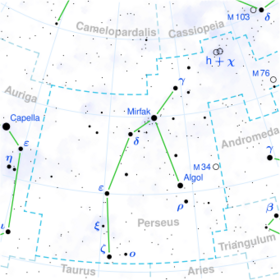Astronomy:HD 21278
| Observation data Equinox J2000.0]] (ICRS) | |
|---|---|
| Constellation | Perseus |
| Right ascension | 03h 28m 03.07229s[1] |
| Declination | 49° 03′ 46.3315″[1] |
| Apparent magnitude (V) | 4.99[2] |
| Characteristics | |
| Spectral type | B5V[3] |
| U−B color index | −0.56[4] |
| B−V color index | −0.10[4] |
| Astrometry | |
| Radial velocity (Rv) | +1.20[5] km/s |
| Proper motion (μ) | RA: +21.784[1] mas/yr Dec.: −26.036[1] mas/yr |
| Parallax (π) | 5.6334 ± 0.2298[1] mas |
| Distance | 580 ± 20 ly (178 ± 7 pc) |
| Absolute magnitude (MV) | −1.49[6] |
| Orbit[7] | |
| Period (P) | 21.695±0.004 d |
| Semi-major axis (a) | ≥6.72 Gm |
| Eccentricity (e) | 0.12±0.04 |
| Periastron epoch (T) | 24,446,714.5±0.2 |
| Argument of periastron (ω) (secondary) | 109±3° |
| Semi-amplitude (K1) (primary) | 22.7±0.9 km/s |
| Semi-amplitude (K2) (secondary) | 49±3 km/s |
| Details | |
| A | |
| Mass | 4.597[8] M☉ |
| Radius | 3.9[9] R☉ |
| Luminosity | 940[6] L☉ |
| Surface gravity (log g) | 4.152±0.113[10] cgs |
| Temperature | 15,274±244[10] K |
| Metallicity [Fe/H] | 0.00[11] dex |
| Rotational velocity (v sin i) | 75[10] km/s |
| Age | 187[11] or 60[6] Myr |
| Other designations | |
| Database references | |
| SIMBAD | data |
HD 21278 is a binary star[7] system in the constellation Perseus, located within the 60±7[6] million year old Alpha Persei Cluster.[7] It has a blue-white hue and is visible to the naked eye with a combined apparent visual magnitude of 4.99.[2] The system is located at a distance of approximately 580 light years from the Sun based on parallax,[1] and it is drifting further away with a radial velocity of +1.20 km/s.[5]
The binary nature of this star was announced in 1925 by Otto Struve.[13] It is a double-lined spectroscopic binary with an orbital period of 21.7 days and an eccentricity of 0.12.[7]
The primary component is a B-type main-sequence star with a stellar classification of B5V,[3] indicating it is generating energy through core hydrogen fusion. The star is spinning with a projected rotational velocity of 75 km/s.[10] It has 4.6[8] times the mass of the Sun and about 3.9[9] times the Sun's radius. HD 21278 is radiating 940[6] times the luminosity of the Sun from its photosphere at an effective temperature of 15,274 K.[10]
References
- ↑ 1.0 1.1 1.2 1.3 1.4 1.5 Brown, A. G. A. (August 2018). "Gaia Data Release 2: Summary of the contents and survey properties". Astronomy & Astrophysics 616: A1. doi:10.1051/0004-6361/201833051. Bibcode: 2018A&A...616A...1G. Gaia DR2 record for this source at VizieR.
- ↑ 2.0 2.1 Anderson, E.; Francis, Ch. (2012). "XHIP: An extended hipparcos compilation". Astronomy Letters 38 (5): 331. doi:10.1134/S1063773712050015. Bibcode: 2012AstL...38..331A. Vizier catalog entry
- ↑ 3.0 3.1 Zuckerman, B. et al. (June 2012). "Stellar Membership and Dusty Debris Disks in the α Persei Cluster". The Astrophysical Journal 752 (1): 12. doi:10.1088/0004-637X/752/1/58. 58. Bibcode: 2012ApJ...752...58Z.
- ↑ 4.0 4.1 Mallama, A. (2014). "Sloan Magnitudes for the Brightest Stars". The Journal of the American Association of Variable Star Observers 42 (2): 443. Bibcode: 2014JAVSO..42..443M.Vizier catalog entry
- ↑ 5.0 5.1 Pourbaix, D. et al. (2004). "SB9: The ninth catalogue of spectroscopic binary orbits". Astronomy and Astrophysics 424 (2): 727–732. doi:10.1051/0004-6361:20041213. Bibcode: 2004A&A...424..727P.
- ↑ 6.0 6.1 6.2 6.3 6.4 Silaj, J.; Landstreet, J. D. (2014). "Accurate age determinations of several nearby open clusters containing magnetic Ap stars". Astronomy & Astrophysics 566: A132. doi:10.1051/0004-6361/201321468. Bibcode: 2014A&A...566A.132S.
- ↑ 7.0 7.1 7.2 7.3 Morrell, Nidia; Abt, Helmut A. (July 10, 1992). "Spectroscopic binaries in the Alpha Persei cluster". Astrophysical Journal, Part 1 393 (2): 666–673. doi:10.1086/171534. Bibcode: 1992ApJ...393..666M.
- ↑ 8.0 8.1 Sheikhi, Najmeh et al. (March 2016). "The binary fraction and mass segregation in Alpha Persei open cluster". Monthly Notices of the Royal Astronomical Society 457 (1): 1028–1036. doi:10.1093/mnras/stw059. Bibcode: 2016MNRAS.457.1028S.
- ↑ 9.0 9.1 Pasinetti Fracassini, L. E. et al. (2001). "Catalogue of Apparent Diameters and Absolute Radii of Stars (CADARS)". Astronomy & Astrophysics 367 (2): 521–24. doi:10.1051/0004-6361:20000451. Bibcode: 2001A&A...367..521P.
- ↑ 10.0 10.1 10.2 10.3 10.4 David, Trevor J.; Hillenbrand, Lynne A. (2015). "The Ages of Early-Type Stars: Strömgren Photometric Methods Calibrated, Validated, Tested, and Applied to Hosts and Prospective Hosts of Directly Imaged Exoplanets". The Astrophysical Journal 804 (2): 146. doi:10.1088/0004-637X/804/2/146. Bibcode: 2015ApJ...804..146D.
- ↑ 11.0 11.1 Gontcharov, G. A. (2012). "Dependence of kinematics on the age of stars in the solar neighborhood". Astronomy Letters 38 (12): 771–782. doi:10.1134/S1063773712120031. Bibcode: 2012AstL...38..771G.
- ↑ "HD 21278". SIMBAD. Centre de données astronomiques de Strasbourg. http://simbad.u-strasbg.fr/simbad/sim-basic?Ident=HD+21278.
- ↑ Struve, O. (December 1925). "Twelve new spectroscopic binaries". Astrophysical Journal 62: 434. doi:10.1086/142944. Bibcode: 1925ApJ....62..434S.
 |


